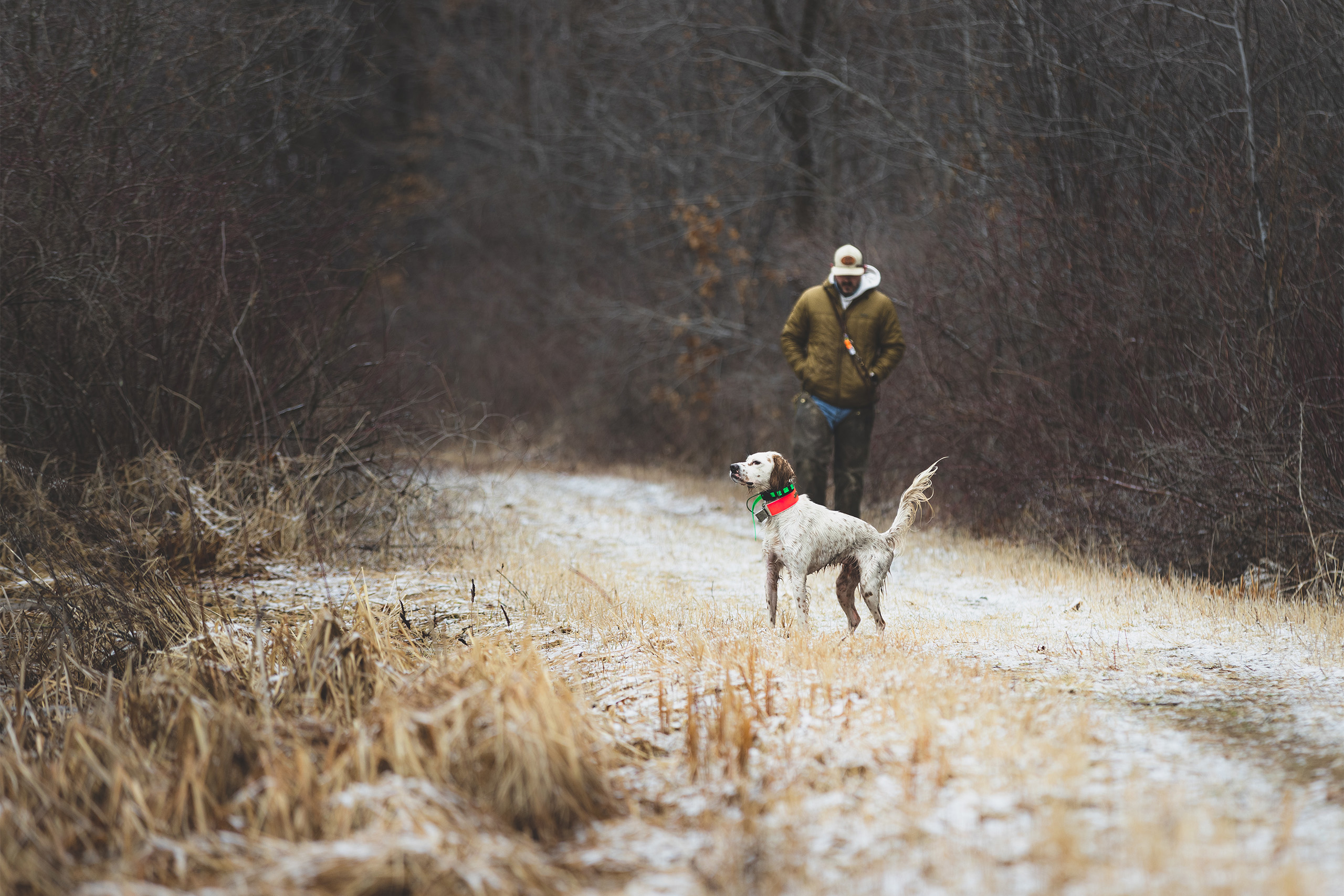Summer Prep and Training for Bird Dogs
Posted by Lucky Duck Team on Jun 6th 2025
Why the Off-Season is On-Time for Excellence: Setting the Stage for a Successful Hunt
Here at Lucky Duck, we know that true mastery in the field doesn't happen by accident. It’s forged in dedication, refined by practice, and built upon a partnership with a canine companion that’s as prepared as you are. While the summer sun might have you dreaming of cooler autumn days and skies full of birds, this off-season is precisely when the groundwork for those memorable hunts is laid.
Think of these warmer months not as downtime, but as prime time. This is your opportunity to sharpen skills, build endurance, and solidify the bond with your bird dog. Consistent, thoughtful preparation now means you won't be scrambling to catch up when opening day is just around the corner. Instead, you'll step into the field with a confident, capable partner, ready to execute flawlessly. The effort invested during the summer pays dividends in steadiness, responsiveness, and ultimately, a heavier game bag. Let's dive into how you can set the stage for your most successful season yet.
Re-Mastering Obedience Essentials This Summer
A well-trained bird dog is a correctly integrated combination of instinct and discipline. While decoys bring the birds into range, your dog’s obedience is the critical component that brings them to you. Summer offers the perfect opportunity to revisit and perfect those foundational commands that ensure control, safety, and seamless teamwork when the pressure is on.
Back to Basics
Never underestimate the power of these core commands. "Sit," "heel," and "here" (or your preferred recall word) are the bedrock upon which all other training stands. A dog that reliably sits and stays, heels calmly by your side through distractions, and comes immediately when called is a dog you can trust in any situation.
The beauty of these basics is their versatility; you can use and reinforce them anywhere, anytime. Whether it's practicing "sit" at feeding time, "heel" during your daily walks, or "here" in the yard, every repetition strengthens that vital connection and understanding. If your dog doesn’t understand and obey these commands at three feet while on a lead, expecting control at a hundred yards during a hunt is a crapshoot.
The Power of "Whoa"
For the retriever owner, "whoa" is a command of almost magical importance. It’s the invisible hand that stops your dog when you need them to stop. A rock-solid, fully trained "whoa" is a critical safety tool and the foundation for advanced steadiness work. Summer is a great time to refine this command, ensuring your dog understands it means to freeze, regardless of distance or temptation.
Consistent Corrections
If you allow your dog to display undesirable behaviors – be it creeping on point, lagging on recall, or jumping – those are the behaviors you'll see in the field. What might seem like a minor slip in the relaxed atmosphere of summer can become an ingrained problem come fall. The longer a behavior is unchecked, the tougher it is to eliminate. While every dog has an occasional hiccup, if you notice repeated mistakes, timely and consistent corrections are in order. Don't let your standards slide during the off-season.
Summer Conditioning for Peak Performance
A successful hunting season demands more than just sharp obedience. You’ll also want your dog to be in peak physical condition. The summer months are your window to build the muscle, endurance, and resilience your bird dog needs to perform tirelessly and safely when the temperatures drop and the days grow long.
Building Stamina Safely in Hot Summer Days
Getting your dog in shape is a marathon, not a sprint, especially during the summer. Start easy with activities like leashed walks (a great time to practice that "heel" command!), games of fetch with a training dummy, or runs in a familiar park. As their fitness improves, you can gradually increase the intensity and duration. However, always be acutely aware of the temperature, sun, and humidity. Water work obviously keeps your dog safer from overheating but you should still keep an eye on the possibility during hot days. When you see from the forecast that the temperature may be a risk, schedule your more strenuous conditioning for early mornings or late evenings and keep sessions focused and productive.
Beyond the Backyard
While backyard drills have their place, conditioning in environments that mimic hunting scenarios offers compounded benefits. Working your dog in open fields with rolling hills, for example, naturally engages a wider range of muscle groups as they navigate uphill and downhill. This not only builds superior physical conditioning but also helps toughen their pads for rugged fall terrain. Furthermore, training in these varied environments socializes your dog to the sights, sounds, and textures they'll encounter during a hunt – fencerows, dense brush, ditches, and water bodies. This exposure builds confidence and helps them become comfortable and effective.
Beating the Heat: Pro Tips for Summer Training Sessions
The summer sun brings longer days, but it also brings the danger of our pups overheating. However, with smart strategies and a keen understanding of your dog’s needs, you can continue to make significant progress while keeping them safe.
Understanding How Your Canine Companion Cools
Unlike humans who sweat through their skin, dogs primarily cool themselves through panting. This rapid exchange of air evaporates moisture from their tongue and the lining of their respiratory tract. This evaporation process cools the blood circulating through these areas, which then helps lower their overall core body temperature.
However, when humidity is high, the air is already saturated with moisture. This dramatically reduces the efficiency of evaporative cooling, making it much harder for your dog to shed heat. That's why a hot, humid day can be far more dangerous than a hot, dry day, even if the thermometer reads the same. Being aware of the heat index or the "feels like" temperature, which accounts for humidity, is important during training days.
Water Work Wonders: Low-Impact, High-Reward Summer Exercise
When the mercury climbs, water becomes your best friend for conditioning. Swimming is a fantastic and low-impact exercise that builds incredible cardiovascular endurance and muscle tone without the concussive stress of running on hard ground. Many bird dogs naturally love water, and retrieving dummies or even just swimming alongside a kayak can be a joyful and effective workout.
However, a word of caution: A shallow, sun-baked pond might be very warm itself and not offer significant cooling if your dog is just wading or sitting in it. But even that warm water can provide a real cooling benefit as it evaporates after they get out of it. And clearly, if the water source itself (like a deeper lake or flowing stream) is genuinely cool, your dog will be in excellent conditions to stay cool during training.
Recognizing the Red Flags: Early Signs of Heat Stress and How to React
Vigilance is key to preventing a dangerous situation. Learn to recognize the early warning signs of heat stress:
- Excessive or Changed Panting: Panting that is much heavier, faster, or seems more desperate than usual. Their tongue may be excessively lolling out.
- Slowing Down: A noticeable decrease in their pace, energy, or enthusiasm. Less animation in their body or a reduction of their usual tail action.
- Loss of Focus/Disorientation: They might seem confused, stumble, or become unresponsive to commands they usually obey.
- Bright Red Gums and Tongue: Though some dogs naturally have redder mouths, a significant change to a very bright red can indicate overheating.
- Thick, Sticky Saliva.
- Vomiting or Diarrhea.
- Weakness or Collapse.
If you notice any of these signs, stop all activity immediately and:
- Move your dog to a shady, cool area.
- Offer small amounts of cool (not ice-cold) water to drink. Don't let them gulp excessively.
- Wet them down with cool water, focusing on their paws, groin, armpits, belly, and ears – areas where blood vessels are close to the skin. Avoid using ice or ice-cold water, as this can constrict blood vessels and paradoxically slow cooling, or even lead to shock.
- If possible, increase air circulation with a fan.
- Even after they seem to recover, be aware that it can take a dog a surprisingly long time to fully cool down internally. Monitor them closely. If signs are severe or your dog doesn’t improve quickly, contact your veterinarian immediately.
The Importance of Bird Exposure and Experience
A perfectly obedient and superbly conditioned dog is a marvel, but without a keen prey drive and familiarity with the hunting environment, its potential remains untapped. The summer off-season is a time to nurture these important aspects.
While formal training drills are essential, don't forget the importance of maintaining that prey drive. Controlled exposure to birds – whether it's pigeons in a training scenario, work at a local sporting dog club, or visits to a hunting preserve – keeps their hunting instincts engaged and their excitement for the game high. This is where the "deception" truly begins to take shape, as they learn to apply their skills to the pursuit of game.
Simultaneously, continue to acclimate your dog to the varied environments they'll encounter during the hunt. As we mentioned in conditioning, training in different types of cover, around water, and over uneven terrain not only builds physical resilience but also acclimates them to a whole host of sights, sounds, and smells. When hunting, that experience will help them to focus on the task at hand.
The Payoff: How Dedicated Summer Prep Translates to Autumn Success
As the summer days gradually shorten and we start counting down to opening day, all those hours spent honing obedience, building stamina, carefully managing heat, nurturing instincts, and ensuring peak health converge to create a canine partner that is ready, eager, and a joy to work with.
Imagine stepping into the field this fall with a dog that responds to your cues with precision, navigates challenging terrain with tireless enthusiasm and grace, and approaches every retrieve with focused intensity.
This is the payoff: Seamless teamwork. The physical conditioning ensures your dog can hunt effectively and safely, day after day. The sharpened instincts mean more birds found and a richer experience for you both.
Gear Up for Success
At Lucky Duck, our kennels are engineered with the serious hunter in mind. Built to withstand the rigors of the field and provide a secure, comfortable haven for your dog, they set the standard for kennel durability and design. Available in Medium, Intermediate, and Large sizes, there’s a Lucky Duck Kennel suited for your hunting partner and your adventures.
Explore the full range of Lucky Kennels and accessories today and ensure your champion is always ready for the next adventure!




